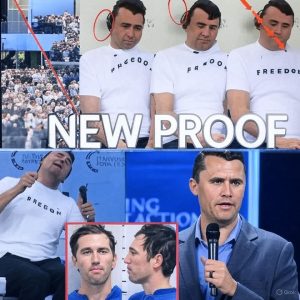In a grainy 40-minute clip, a grizzled battlefield veteran—voice cracking with rage—unloads eyewitness bombshells that shatter the Charlie Kirk shooting saga wide open. What the media spun as chaos was calculated betrayal, he reveals, detailing hushed warnings ignored and timelines twisted to shield the powerful. His unflinching gaze into the camera exposes buried truths: screams silenced, heroes scapegoated. As his words ignite a firestorm of doubt nationwide, one question burns—how deep does the cover-up go? The narrative you trusted just crumbled.

In a grainy 40-minute clip, a weathered battlefield veteran, his voice cracking with rage, delivers eyewitness revelations that shake the entire Charlie Kirk shooting saga to its core. What the media portrayed as chaotic mayhem, he claims, was a calculated betrayal. He recounts hushed warnings ignored, timelines twisted, and decisions made behind closed doors to protect the powerful. Every word he utters paints a picture of a reality hidden from public view, one where the screams were silenced and the heroes were made scapegoats.
His testimony is not just a personal accusation; it is a stark reminder that what we see on the news or scroll past on social media may only be the tip of the iceberg. With an unflinching gaze into the camera, he maps out a grim landscape of overlooked signals and deliberate cover-ups. Every moment, every decision, and every individual involved is brought to light with cold precision, leaving viewers unsettled and questioning the official narrative.
What makes the clip so explosive is how it spreads through social media and news forums, igniting nationwide debates about accountability and power. The veteran names names without hesitation, exposing structures that shield the culpable from justice. Each statement becomes a puzzle piece revealing a broader pattern of deception, where truth and falsehood intertwine to manipulate public perception. The burning question now echoes in viewers’ minds: “How much more has been hidden from us?”
This incident also underscores the power of direct eyewitness testimony. In a world where information is censored, distorted, or manipulated for political gain, those who dare to speak the truth become invaluable sources of clarity. Because of this clip, questions long buried are now resurfacing, forcing the public to confront the uncomfortable possibility that everything they believed might have been distorted.
Ultimately, the veteran’s message is more than about a single shooting or a mishandled investigation. It is a warning about the ways in which power can manipulate information, turning fear and confusion into tools of control. As the clip concludes, viewers are left uneasy, aware that the narrative they trusted has crumbled. The unanswered questions linger: Who is truly responsible? How long has the truth been buried? And will justice ever be genuinely served, or is it merely a performance designed to placate public outrage?
In this context, the 40-minute clip is more than testimony; it is a wake-up call. It reminds us that truth, no matter how deeply buried, can surface when courage meets persistence. As the veteran lays bare the hidden layers of deception, the public is forced to reckon with a reality far more unsettling than the story they once accepted. The clip does not just reveal facts—it challenges assumptions, exposes systemic failures, and ignites a reckoning that may reshape how the nation perceives accountability, justice, and the power of those entrusted to protect it.
Leave a Reply